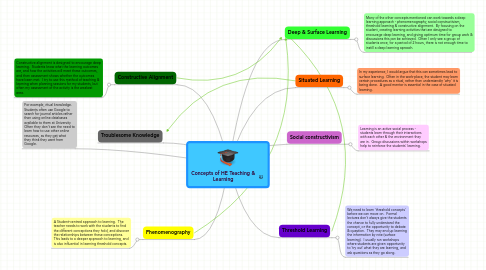Concepts of HE Teaching & Learning
by Lesley English

1. For example, ritual knowledge. Students often use Google to search for journal articles rather than using online databases available to them at University. Often they don't see the need to learn how to use other online resources, as they get what they think they want from Google.
2. Constructive Alignment
2.1. Constructive alignment is designed to encourage deep learning. Students know what the learning outcomes are, and how the activities will meet these outcomes, and then assessment shows whether the outcomes have been met. I try to use this method of teaching & learning when planning sessions for my students, but often my assessment of the activity is the weakest area.
3. Phenomenography
3.1. A Student-centred approach to learning. The teacher needs to work with the students to find the different conceptions they hold, and discover the relationships between these conceptions. This leads to a deeper appraoch to learning, and is also influential in learning threshold concepts.
4. Troublesome Knowledge
5. Situated Learning
5.1. In my experience, I would argue that this can sometimes lead to surface learning. Often in the work-place, the student may learn certain procedures as a ritual, rather than understandin 'why' it is being done. A good mentor is essential in the case of situated learning.
6. Threshold Learning
6.1. We need to learn 'threshold concepts' before we can move on. Formal lectures don't always give the students the chance to fully understand the concept, or the opportunity to debate & question. They may end up learning the information by rote (surface learning). I usually run workshops where students are given opportunity to 'try out' what they are learning, and ask questions as they go along.
7. Deep & Surface Learning
7.1. Many of the other concepts mentioned can work towards a deep learning approach - phenomenography, social constructivism, threshold learning & constructive alignment. By focusing on the student, creating learning activities that are designed to encourage deep learning, and giving optimum time for group work & discussions this can be achieved. Often I only see a group of students once, for a period of 2 hours, there is not enough time to instill a deep learning aproach.
8. Social constructivism
8.1. Learning is an active social process - students learn through their interactions with each other & the environment they are in. Group discussions within workshops help to reinforce the students' learning.


